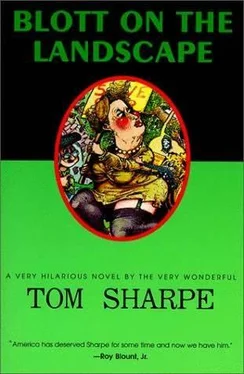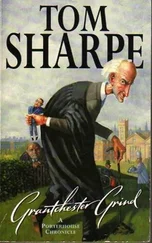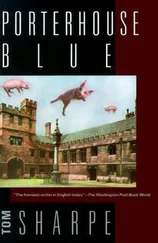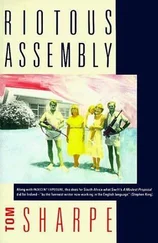Tom Sharpe - Blott on the Landscape
Здесь есть возможность читать онлайн «Tom Sharpe - Blott on the Landscape» весь текст электронной книги совершенно бесплатно (целиком полную версию без сокращений). В некоторых случаях можно слушать аудио, скачать через торрент в формате fb2 и присутствует краткое содержание. Жанр: Современная проза, на английском языке. Описание произведения, (предисловие) а так же отзывы посетителей доступны на портале библиотеки ЛибКат.
- Название:Blott on the Landscape
- Автор:
- Жанр:
- Год:неизвестен
- ISBN:нет данных
- Рейтинг книги:5 / 5. Голосов: 1
-
Избранное:Добавить в избранное
- Отзывы:
-
Ваша оценка:
- 100
- 1
- 2
- 3
- 4
- 5
Blott on the Landscape: краткое содержание, описание и аннотация
Предлагаем к чтению аннотацию, описание, краткое содержание или предисловие (зависит от того, что написал сам автор книги «Blott on the Landscape»). Если вы не нашли необходимую информацию о книге — напишите в комментариях, мы постараемся отыскать её.
Blott on the Landscape — читать онлайн бесплатно полную книгу (весь текст) целиком
Ниже представлен текст книги, разбитый по страницам. Система сохранения места последней прочитанной страницы, позволяет с удобством читать онлайн бесплатно книгу «Blott on the Landscape», без необходимости каждый раз заново искать на чём Вы остановились. Поставьте закладку, и сможете в любой момент перейти на страницу, на которой закончили чтение.
Интервал:
Закладка:
In the greenhouse Blott put down the earphones and went back to the broad beans. So an official was coming to see Sir Giles, was he? An official. Blott felt strongly about officials. They had made his early life a misery and he had no time for them. Still, Lady Maud had invited this one to the Hall so presumably she knew what she was doing. It was a pity. Blott would have liked to have been ordered to give this Dundridge the reception he deserved and he was just considering what sort of reception he would have organized for him when Lady Maud came into the garden. Blott straightened up and stared at her. She was wearing a cotton frock and to Blott at least she looked quite beautiful. It was not a notion anyone else would have shared but Blott’s standards of beauty were not determined by fashion. Large breasts, enormous thighs and hips were attributes of a good or at least ample mother, and since Blott had never had a good, ample or even any mother in a postnatal sense he placed great emphasis on these outward signs of potential maternity. Now, standing among the broad beans, he was filled with a sudden sense of desire. Lady Maud in a cotton frock dappled with a floral pattern combined botany with biology. Blott goggled.
“Blott,” said Lady Maud, oblivious of the effect she was having, “there’s a man from the Ministry of the Environment coming to lunch. I want some flowers in the house. I want to make a good impression on him.”
Blott went into the greenhouse and looked for something suitable while Lady Maud bent low to select a lettuce for lunch. As she did so Blott glanced out of the greenhouse door. It was the turning point in his life. The silent devotion to the Handyman family which had been the passive mainspring of his existence for so long was gone, to be replaced by an active urgency of feeling.
Blott was in love.
Chapter 9
Dundridge left Worford by the town gate, crossed the river and took the Ottertown road. On his left the Cleene wandered through meadows and on his right the Cleene Hills rose steeply to a wooded crest. He drove for three miles and turned up a side road that was signposted Guildstead Carbonell and found himself in evidently hostile territory. Every barn had the slogan “Save the Gorge” whitewashed on it and there were similar sentiments painted on the road itself. At one point an avenue of beeches had been daubed with letters that spelt out “No to the Motorway” so that as he drove down it Dundridge was left in no doubt that local feeling was against the scheme.
Even without the slogans Dundridge would have been alarmed. The Cleene Forest was nature undomesticated. There was none of that neatness that he found so reassuring in Middlesex. The hedges were rank, the few farmhouses he passed looked medieval, and the forest itself dense with large trees, humped and gnarled with bracken growing thickly underneath. He was relieved when the road ran into an open valley with hedges and little fields. The respite was brief. At the top of the next hill he came to a crossroads marked by nothing more informative than a decayed gibbet.
Dundridge stopped the car and consulted his map. According to his calculations Guildstead Carbonell lay to the left while in front was the Gorge and Handyman Hall. Dundridge wished it wasn’t. Below him the forest lay thicker than before and the road less metalled, with moss and grass growing down the middle. He drove on for a mile and was beginning to wonder if the map had misled him when the trees thinned and he found himself looking down into the Gorge itself.
He stopped the car and got out. Below him the Cleene tumbled between cliffs overgrown with brambles, ivy and creepers. Ahead lay Handyman Hall. It stood, an amalgam in stone and brick, timber and tile and turret, a monument to all that was most eclectic and least attractive in English architecture. To Dundridge, himself a devotee of function, for whom simplicity was all, it was a nightmare. Ruskin and Morris, Gilbert Scott, Vanbrugh, Inigo Jones and Wren to name but a few had all lent their influence to a building that combined the utility of a water-tower with the homeliness of Wormwood Scrubs. Around it lay a few acres of parkland, a wall, and beyond the wall a circle of hills, heavily wooded. Over the whole scene there lay a sense of isolation. Somewhere to the west there were presumably towns and houses, shops and buses, but to Dundridge it seemed that he was standing on the very edge of civilization if not actually beyond it. With the sinking feeling that he was committing himself to the unknown he got back into the car and drove on, down the hill into the Gorge. Presently he came to a small iron suspension bridge across the river which rattled as he drove over. On the far side something large and strange loomed through the trees. It was the Lodge. Dundridge stopped the car and gaped at the building through the windshield.
Constructed in 1904 to mark the occasion of the visit of Edward the Seventh, the Lodge, in deference to the King’s Francophilia, had been modelled on the Arc de Triomphe. There were differences. The Lodge was slightly smaller, its frieze did not depict scenes of battle, but for all that the resemblance was remarkable and to Dundridge its existence in the heart of Worfordshire came as final proof that whoever had built Handyman Hall had been an architectural kleptomaniac. Above all the Lodge bespoke a lofty arrogance which, coming so shortly after Lord Leakham’s outburst, made a tactful approach all the more necessary. As he stood looking up at it Dundridge was recalled to his task. Some sort of compromise was clearly necessary to avoid his becoming embroiled in an extremely nasty situation. If the Ottertown route was out of the question and he had it on the highest authority that it was, and if the Gorge… There was no if about the Gorge, Dundridge had seen enough to convince him of that, then a third route was imperative. But there was no third route. Dundridge got back into his car and drove thoughtfully through the great arch and as he did so a vision of the third route dawned upon him. A tunnel. A tunnel under the Cleene Hills. A tunnel had all the merits of simplicity, of straightness and, best of all, of leaving undisturbed the hideous landscape that so many irate and influential people inexplicably admired. There would be no more wrangles about property rights, no compensation, no trouble. Dundridge had discovered the ideal solution.
In the entrance hall Lady Maud, radiant in Tootal, lurked among the ferns. High above her head the stained-glass roof-light cast a reddish glow upon the marble staircase and lent a fresh air of apoplexy to the ruddy faces of her ancestors glowering down from the walls. Lady Maud patted her hair in readiness. She had laid her plans. Mr Dundridge would get the gracious treatment, at least to begin with. After that she would see how he responded. As his car crunched on the gravel outside she adjusted her step-in and gave a practice smile to a vase of snapdragons. Then she stepped forward and opened the door.
“Nincompoop? Nincompoop? Did you say nincompoop?” said Sir Giles. In his constituency office situated conveniently close to Hoskins’ Regional Planning Board the word had a reassuring ring to it.
“A perfect nincompoop,” said Hoskins.
“Are you sure?”
“Positive. A first rate, Grade A nincompoop.”
“It sounds too good to be true,” said Sir Giles doubtfully. “You can’t always go by appearances. I’ve known some very slippery customers in my time who looked like idiots.”
“I’m not going by appearances,” Hoskins said. “He doesn’t look an idiot. He is one. Wouldn’t know one end of a motorway from the other.”
Sir Giles considered the statement. “I’m not sure I would come to that,” he said.
Читать дальшеИнтервал:
Закладка:
Похожие книги на «Blott on the Landscape»
Представляем Вашему вниманию похожие книги на «Blott on the Landscape» списком для выбора. Мы отобрали схожую по названию и смыслу литературу в надежде предоставить читателям больше вариантов отыскать новые, интересные, ещё непрочитанные произведения.
Обсуждение, отзывы о книге «Blott on the Landscape» и просто собственные мнения читателей. Оставьте ваши комментарии, напишите, что Вы думаете о произведении, его смысле или главных героях. Укажите что конкретно понравилось, а что нет, и почему Вы так считаете.












